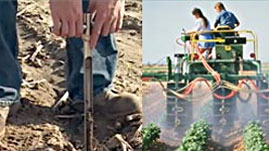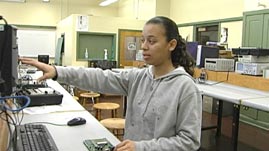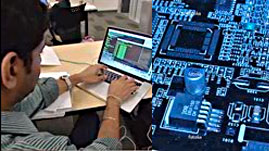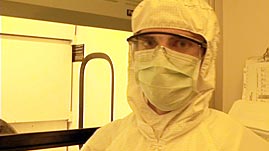Teachers' Domain - Digital Media for the Classroom and Professional Development
User: Preview
Many of the new jobs available today didn't exist a decade ago. Advanced Technological Education (ATE) programs are one way that today’s students can prepare for careers in the emerging high-technology workplace. People trained in high-tech fields can be involved in national security, food or energy production, game design, or the development of new products and medicines.
The opportunities are exciting, but in order to find them, students must first know that they exist. Then they need to find ways to prepare themselves for entry into a relevant ATE program that is suited to their skills and interests. This is where your guidance can help.

Advanced technological education (ATE) programs are designed to prepare a twenty-first-century work force for high-tech careers. These programs follow existing industry trends, training technicians for jobs today, but they are also at the forefront of innovation, developing new technologies that will impact business and society—and create new jobs—in the future.
ATE programs can be found at community colleges, technical colleges, and any of the 39 ATE centers funded by the National Science Foundation. Through these programs, students earn degrees and certificates and gain specialized knowledge and skills that prepare them for success in their chosen field.
In this lesson, you will look at several high-tech areas in detail. You will also answer questions and take notes throughout the session—record your answers in the space provided and click "save notes." You will end the lesson by continuing to research ATE programs in your area that best suit your students' interests and then developing some next steps.

Take a look at the following list and consider which might be most interesting to the students you work with:
Next, look at Web sites for community and technical colleges near you to see which technology programs they offer. You may want to start your search at ATE Centers. Based on your students' interests, think about how you might help them find programs where they could pursue those interests. Then answer the questions below:
In which technologies do the programs in your area specialize? Which technologies are not represented at your local colleges? If one of your students had a particular interest in biotechnology, or engineering, or green technologies, how would you direct them toward this career path?
Before continuing, if some of the areas listed above are particularly relevant to your students, you can use the buttons below to skip ahead to those screens. When you're finished exploring the most relevant technological areas, go to the "Applying the Lesson" screen to complete the lesson.

Video: 3m 08s
Manufacturing today requires a complete set of technical skills, including an understanding of computer software and hardware. In this video, a biomanufacturing supervisor working for a leading medical devices company discusses some of the challenges he faces in his position and the types of skills required to do this job well. Click "View" on the left to watch the video.
After watching the video, list and describe three skills your students will likely need to master if they decide to pursue a career in manufacturing. Which of these skills are they gaining in high school, and which will they need to pursue outside of the classroom or after they graduate?

Interactive
As the world's population grows, so does the demand for food, clean water, and power. Community and technical colleges across the United States are at the forefront of efforts to prepare students for careers in emerging technology fields that may revolutionize how we sustain a growing global population.
This interactive activity explores three possible career paths in agricultural and environmental technologies: farming and agricultural production, science and information management, and environmental services and systems. Click "View" on the left to begin.
After completing the activity, list some of the jobs in this field that might interest your students, and describe the knowledge and skills they might need to be successful in these careers. Identify where they might acquire this knowledge and these skills in your current curriculum.

Video: 2m 39s
Do you have students who are particularly interested in biology and chemistry lab work? If so, they might want to consider a program in biotechnology, one of the fastest-growing industries in the world.
In this video segment, high school student Daphnee applies her interest in biotechnology by taking afterschool classes at her local community college. Daphnee describes her job-shadowing experience at a biotechnology company, where she has the opportunity to observe a biotechnician at work and to ask questions that will help her decide if this field is right for her.
Click "View" on the left to watch the video. As you watch, think about whether you have students like Daphnee, who prefer hands-on activities to learning solely from a textbook. What kinds of questions would you ask your students to determine possible interest in this kind of laboratory work?
After you watch the video, describe three skills your students might need in order to be successful in a career in biotechnology. Identify where the students might acquire these skills in your current curriculum.

Video: 2m 47s
Electronics is one of the oldest and most established of the technical fields. However, like other high-tech careers, it is changing quickly and being applied to an increasingly diverse number of jobs and industries.
In this video, Monica Colón pursues a career as a biomedical technician through a program in medical electronics engineering. Biomedical technology increasingly relies on professionals who can operate and maintain high-tech medical equipment. Through classes at her community college—often a mix of lectures and hands-on labs—Monica is learning technical skills as well as a variety of nontechnical skills that will help her throughout her career. Click "View" on the left to watch the video.
In addition to the variety of technical skills she is gaining, Monica's career choice will require a number of other professional skills. What are some of the nontechnical skills that potential employers tend to look for? How can you help your students develop these skills? How can you incorporate these skills into your current curriculum?

Interactive
With the goal of reducing the consumption of natural resources and capitalizing on renewable sources of energy, green technologies span a wide variety of industries. Green technologies influence how we build, what materials our products are made of, how we get from place to place, and what we use for power.
In this interactive activity, explore five different areas of research and innovation in green technologies: renewable energy and conservation, green building, transportation, manufacturing, and pollution and waste management. Click "View" on the left to begin.
After completing this activity, research green technologies and green-technology-enabled companies in your area. List three local companies or technical career opportunities your students might be interested in. Based on the community college research you did previously, which programs would help your students prepare for a career in green technologies?

Interactive
As our reliance on computers and rapid data transfer grows, so do the career opportunities in information and security technologies. Students with an interest in this field will find a wide variety of ATE programs around the country that specialize in training students to build, install, and/or maintain effective and secure computer systems.
This interactive activity explores three possible career paths in information and security technologies: administration, development, and integration. Explore each path to learn more about the education and experience required for particular jobs in those areas. Click "View" on the left to begin.
After completing the activity, list three career opportunities in this field that you think some of your students might be interested in, and describe what steps they might take while in high school to gain experience toward a technical program of this type.

Video: 3m 53s
Micro- and nanotechnologies are at the leading edge in the development of new and emerging materials and devices. This is because tiny particles sometimes act differently than larger particles of the same substance; they might possess different physical and chemical properties and, as a result, can be used in new and exciting ways. This has created a number of unique industry and career opportunities.
One of the main differences between micro- and nanotechnologies is the size of the particles or devices used in these fields. Microtechnology works with and builds devices in the micro-range (between 100 nanometers [nm] and 100 micrometers). Nanotechnology works with and builds components in the nano-range (between 1 nm and 100 nm). Because there is much overlap between these two technologies, the fields require similar knowledge and skills.
This video examines nanotechnology, the art and science of manipulating and rearranging individual atoms and molecules to create useful materials, devices, and systems. Click "View" on the left to watch the video.
What skills do you think are important for a student interested in micro- and nanotechnologies to have? What courses would you recommend to students who are interested in a career in micro- and nanotechnologies?

In this lesson you have explored many of the fields that use advanced technology, the kinds of people who are pursuing high-tech careers, and the education and experiences your students will need to succeed in a high-tech industry. Now it's time to review your responses in previous sections and to develop some next steps. Click "review my work" above and view or print out the screen that pops up.
Use your notes to continue researching ATE programs in your area that best suit your students' interests. You might conduct a survey to get a better sense of their interests. Based on their responses, identify relevant high-tech businesses in your area and contact their human resources departments about possible industry tours, job-shadowing opportunities, or internship programs for high school students or recent graduates. Make note of these programs and any relevant contact information that you or your students might use in the future.
Then direct students who might be interested in a high-tech career toward the Planning Your Future Career in Advanced Technology self-paced lesson.
After they have completed the lesson, you can help them develop a mission statement and can continue to be available as a resource for information and guidance as they pursue a career in one of these exciting fields.
ATETV
Pellet Productions, Inc.
AIME:
Young woman with hard hat [top left]
Young man with goggles [top right]
Student and teacher with solar car [bottom right]
Model vehicle [center]
Technician at computer ©iStockphoto.com/ryasick [bottom left]
ATETV
Pellet Productions, Inc.
AIME:
Young man in cart [top right]
Quality control testing ©iStockphoto.com/Joerg Reimann [bottom right]
LED light ©shima-risu/Fotolia [bottom left]
Researcher looking at slide ©WGBH [top left]
Teachers' Domain, Changing Student Lives Through Advanced Technological Education, published October 24, 2011, retrieved on ,
http://www.teachersdomain.org/resource/ate10.ate.pd.splcareers/
Media Type:
Self-paced Lesson
Professional Development:
WGBH is trying to develop materials that better meet the needs of our users. Please take this brief survey to share how you use these resources and to provide feedback on your experiences using these materials. Take the Survey!
In this lesson designed for professional development, learn about rapidly emerging fields in advanced technology that your students may find of interest when considering a career. You will watch videos, explore interactive activities, and answer content-related questions to gain insights into the various industries that use advanced technology, the kinds of people working in or training for these jobs, and the skills and education needed to succeed. Then you will research ATE programs in your area that align with your students’ interests and inquire about internships and other firsthand experiences high school students may use to evaluate possible career pathways.
To help improve this service, please report and describe any standards correlations that you find to be inaccurate.
Academic standards correlations on Teachers' Domain use the Achievement Standards Network (ASN) database of state and national standards, provided to NSDL projects courtesy of JES & Co.
![]()
We assign reference terms to each statement within a standards document and to each media resource, and correlations are based upon matches of these terms for a given grade band. If a particular standards document of interest to you is not displayed yet, it most likely has not yet been processed by ASN or by Teachers' Domain. We will be adding social studies and arts correlations over the coming year, and also will be increasing the specificity of alignment.
You must be signed in to see standards matches for your state.
 Loading Standards
Loading Standards Teachers' Domain is proud to be a Pathways portal to the National Science Digital Library.
Teachers' Domain is proud to be a Pathways portal to the National Science Digital Library.
Major funding for Teachers' Domain was provided by the National Science Foundation.
Teachers Domain® Home | Change Edition
About Teachers' Domain | Contact Us | Privacy Policy | Terms of Use
Teachers' Domain: © 2002-2025 WGBH Educational Foundation | shopPBS Educational Media


